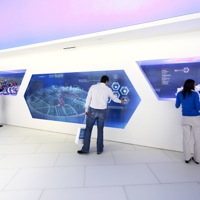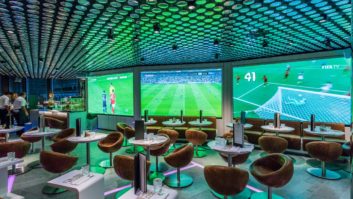
When Christie launched MicroTiles in New York late in 2009 (in Europe at ISE 2010), the company’s description of it as “ground-breaking” didn’t seem – for once in the AV industry – overblown. Highly respected Insight Media senior analyst Chris Chinnock said at the time: “Christie think they are on to something with this product. I agree.” His thoughts were echoed by no-less-respected commentator Gary Kayye, who opined that “to be perfectly honest, we don’t even think that Christie has a handle on how big of a product they have on their hands with MicroTiles”. And, as Joe Graziano, Christie’s EMEA market development manager for MicroTiles, points out, other companies have been quick to see the opportunity and enter the market.
While tiling multiple displays to create large images was nothing new – it has been a staple of the videowall industry in applications such as control rooms for some time – what the introduction did was to make the industry re-evaluate what was possible with display technology. “Tiled flatpanel displays create many more options in terms of display shapes, sizes and locations,” notes Peter Bussens, market director for control rooms and simulation at Barco. “The type of content is much more flexible and attractive for display walls. Tiled flatpanel displays offer flexible screen dimensions and shapes – even in rooms with small footprints. The resolution scales with the number of panels and the brightness doesn’t depend on the luminance of a projector and stays constant independent of the active screen area.”
“This new display technology will enable businesses to be more creative,” adds Phil Gaut, general manager – display at Samsung UK & Ireland, whose company will introduce its UD22 tile display in the UK in August. “They will no longer be limited to a regular rectangular display. Retailers, for example, will now be able to showcase their products in an eye-catching way by incorporating tiled displays with products.” At ISE this year, Samsung had an eye-catching demonstration featuring five UD22 tile displays and four display cabinets with designer jewellery. “With a regular large-format display, a retailer would not be able to create this effect,” points out Gaut, “and instead would need to rely on non-digital displays with a reduced marketing impact.” “More people are asking us about the opportunities for creative and curved installations but these take longer to come to fruition as the bracketry has to be designed to support them,” notes Steve Scorse, vice president of Prysm EMEA. Prysm’s tiles are 25in in size, and feature a seam of 0.25mm. They are also characterised by their low power consumption. “We have installations on the horizon for the summer months which will have unique elements behind them to showcase the possibilities that videowalls offer.”
New opportunities
“Tiled displays have created new markets where it hasn’t been possible in the past to use projection to create large images because of ambient light conditions, space and so on,” says Eric Hénique, director of marketing and international sales at eyevis. “But,” he continues, “as well as creating a new market, there is an extent to which they have also replaced projection technology – for example, replacing existing projection or rear-projection installations because of their smaller size and also the lower investment that is often required.”
Certainly, before the advent of videowalls with flat screens and acceptably narrow bezels, projection was the only way of delivering a large image. According to Christie’s Graziano, it still has its place. “Projection should under no circumstances be ignored in today’s world,” he says, “because projectors are still the only way to truly realise a large-format seamless display without the interference of bezels, and that can achieve incredible brightness and high resolution. With recent improvements in lamp life expectancy and edge-blending capabilities, projection used for appropriate applications delivers excellent performance value. However, the understanding of a customer’s requirements and how technologies best perform in particular applications is critical as, in many cases, tiled display technologies are a more appropriate option.”
Working together
Of course, projection and tiled displays are not mutually exclusive: both Christie’s MicroTiles and eyevis’s omniSHAPES use single-chip DLP projection technology to create the image. eyevis’s squareTILES, on the other hand, are LCD-based, as is the Samsung UD series. Graziano also points out the difficulties encountered with legacy tiled displays – difficulties that include ensuring colour uniformity across a wall; the challenge presented when a panel goes out of production, meaning that no replacement or upgrade is available; and the additional power consumption and building stress of tiled displays. “But,” says Graziano, “Christie invested considerably in R&D before launching MicroTiles, with the aim of solving these common issues in tiled displays – and that effort has paid off.”
Then, there is the issue of relative cost. But, as Hénique points out, that’s not straightforward. It’s easy to think of a tiled display as being the more expensive option – but that’s not necessarily the case. “It depends on the brightness level of the projector that would alternatively be used,” he says, “because the more brightness a projector provides, the more expensive it will be. So if it was possible to use normal meeting-room projectors, a matrix of displays/tiles will probably be more expensive. On the other hand, if very bright projectors were the alternative, a tiled display solution may well be cheaper.” Beyond these considerations, there is also the requirement to take into account the expertise that is necessary – and available. “To achieve a good installation, an integrator with a skill set and understanding of tiled technologies is paramount,” says Graziano. “The connectivity of sources and flexibility of tiled arrays could mean that the cabling is extensive. Deployments need to be designed with well-planned cable management and consistency in mind, to assist maintenance. Tiled displays need setting up accurately to ensure the best results in terms of colorimetry. “But,” he concludes, “for trained integrators, tiled displays should be well within their capabilities.”
Pros and cons
Bussens doesn’t believe that the additional complexity necessarily creates a barrier either. “Tiled display walls are easily set up in various configurations,” he says. “There is generally less space required for a tiled display wall than a projector-based system, which needs to be a certain distance from the wall and needs to be configured in a way that nothing will pass in front of the projection. Modular display wall systems are also quite easy to install when there is a well-engineered structure behind them. There is more effort in cabling, however – but it is straightforward work.”
But if there is a choice between projection and tiles to create an image, there is no less of a choice between small tiles and large tiles. “The ability to create a striking display wall that is flexible in shape is the strongest advantage of small display tiles, as they are easy to handle, install and come in various shapes,” continues Bussens. “However, they are also expensive, have poor resolution and you have to connect all of the tiles together. Additionally, there are a lot of seams where each tile meets another. Small display tiles are primarily used in applications where the image quality is not the main driver.”
Hénique sees things similarly. “A major advantage is the easier handling and the higher resolution that can be achieved,” he points out. “With projection-based tiles, it is also true that the brightness level is higher, the smaller the tile. The disadvantage may be that the number of devices required to build up a videowall is larger than with larger tiles/modules, hence the number of bezels/gaps will rise accordingly. The more displays that are used, the more complex the cabling and connections for control.”
The disagreement between Bussens and Hénique about the resolution of small tiles can be attributed to different views. Individual small tiles will certainly be of lower resolution than their larger counterparts – but, cumulatively, they can deliver an image of very high resolution. Hénique points out that this higher cumulative resolution could make a display readable from closer than would otherwise be possible. Certainly, portability and ease of installation has proven to be a major asset for smaller tiles; as such, they’re finding significant favour in the rental/staging world for applications such as exhibitions and trade shows.
Gaut picks up on Bussens’ point about desired image quality in determining whether large or small tiles will be more appropriate for a given application. “The argument between large or small tiled displays really comes down to acceptance of the number of seams,” he says. The AV industry has historically looked to achieve image perfection – but has woken up to the fact that there are numerous potential applications that do not have to deliver seamless, photographic images. Sometimes, they just need to look good and attract attention.
Gaut continues: “You can imagine using tiled displays perhaps as stepping stones between two larger video walls, or using a series of square displays each of which spells out the letters of the company’s name – with each display continuously changing,” he muses. “You could even design a large videowall using, for example, our UD55 55in panels – but incorporate the UD22 to finesse the edges.”
It’s this kind of creativity that is increasingly spurring the adoption of small tiles. “The onset of products like Christie MicroTiles has altered the thinking about traditional 16:9 or 4:3 displays,” says Graziano. “Tiled displays allow this flexibility and the smaller the individual tile, the more adaptable they are. We have seen MicroTiles deployed in bar surfaces as a digital menu, on ceilings and in window displays with vacant tiles used for product placement yet surrounded by a digital array for advertising ?– not to mention curved arrays.”
Prysm’s Steve Scorse is similarly enthused by the possibilities. “Small display tiles offer a wealth of possibilities for creative installations in the shape of logos, columns, strips, archways, zig-zags of curved formations and so on,” he says. “They also allow for digital displays in spaces that would previously have been out of bounds with a fixed size flatpanel or projector. Smaller tiles also have an advantage for placement in unusual locations which really catch the eye of passers-by.”
eyevis has taken the concept a step further: its omniSHAPES come not only as rectangles, but also in five-sided and six-sided versions. For customers for whom even that’s not enough, eyevis says that it can create custom shapes. Given their wide-ranging advantages, and the opportunities they present, it’s no surprise that tiled displays – and especially those featuring smaller tiles – are capturing attention. Graziano is, equally unsurprisingly, bullish. “The technology is gathering momentum and is here to stay for the foreseeable future,” he asserts. “The challenge for the manufacturers is to continuously improve it.”It seems unlikely that manufacturers won’t rise to that challenge.
Ian McMurray
www.barco.com
www.christiedigital.eu
www.eyevis.de
www.prysm.com
www.samsung.com/uk/business







